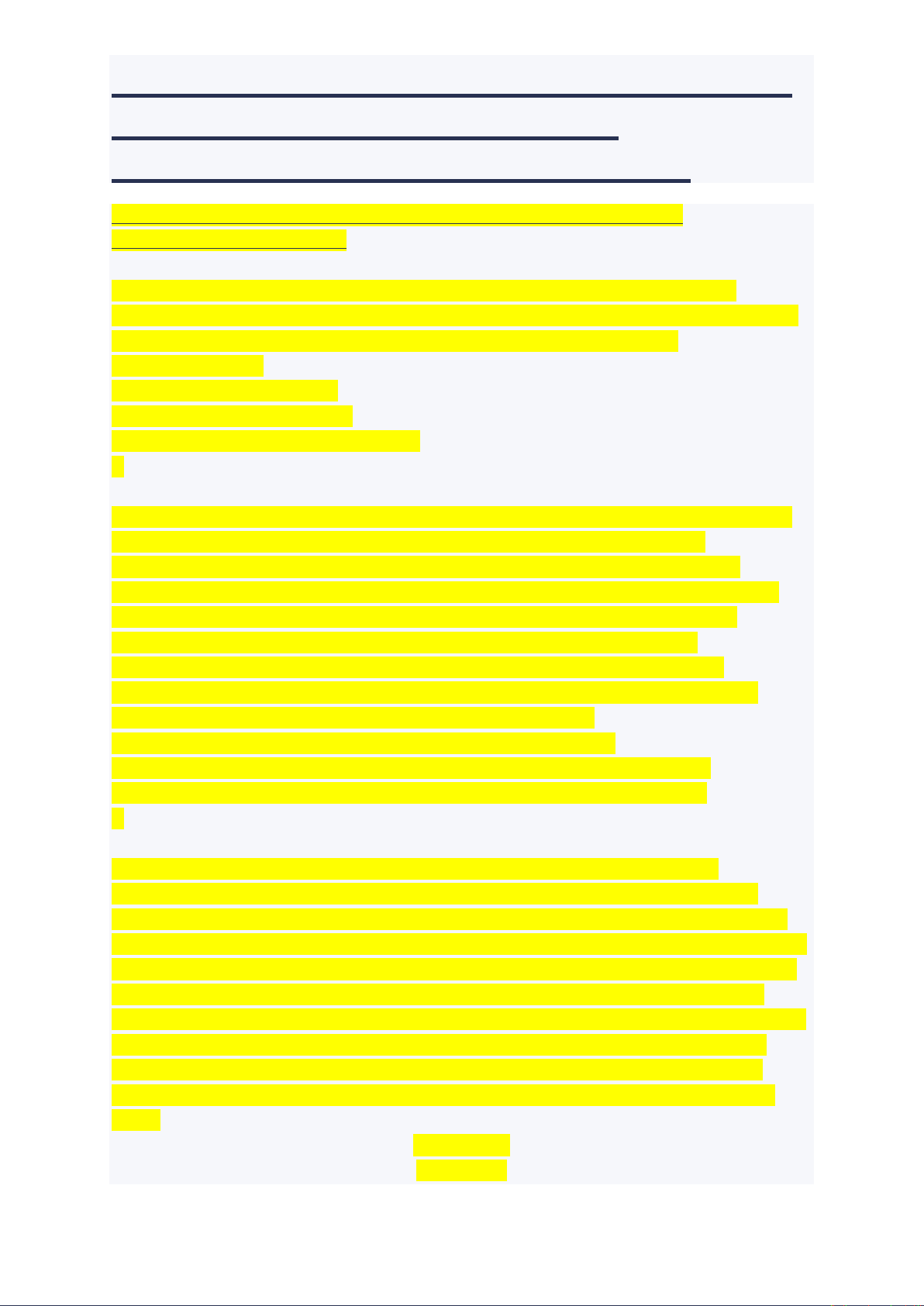
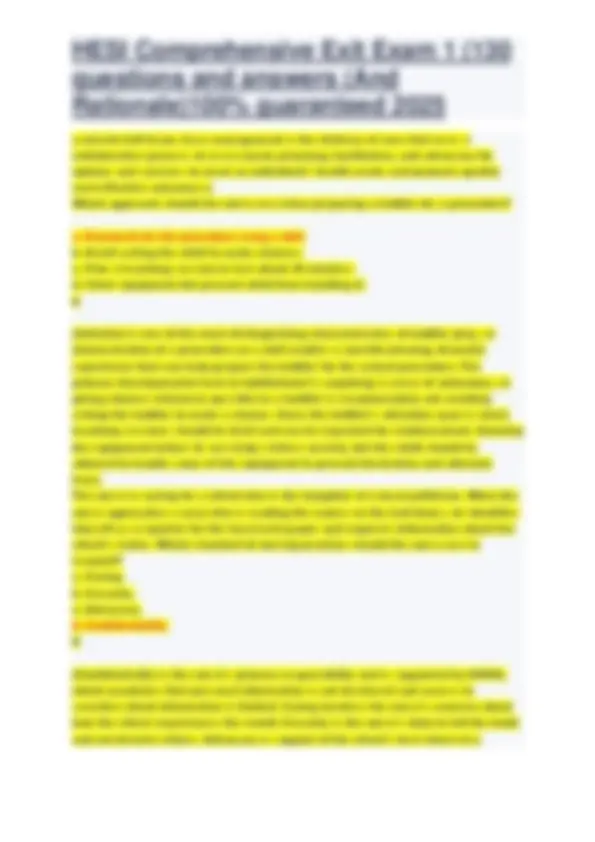
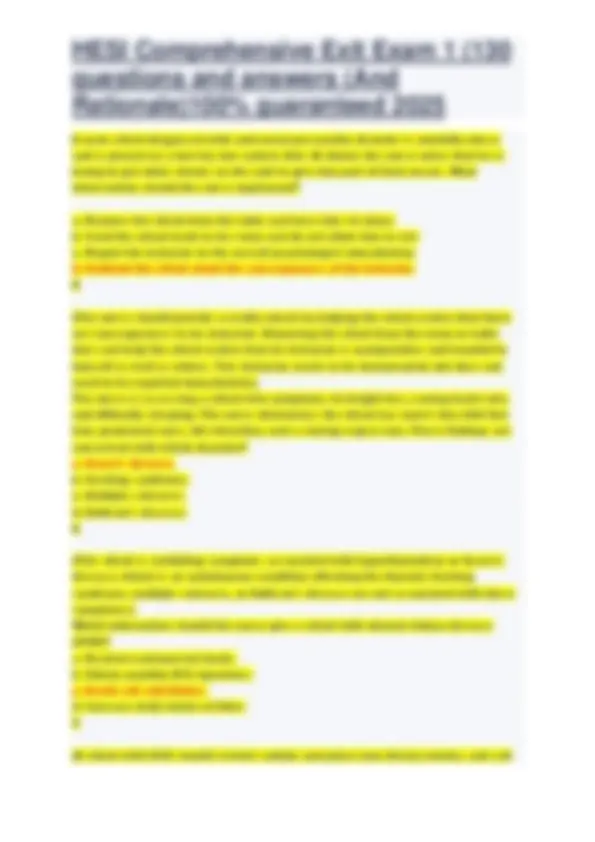
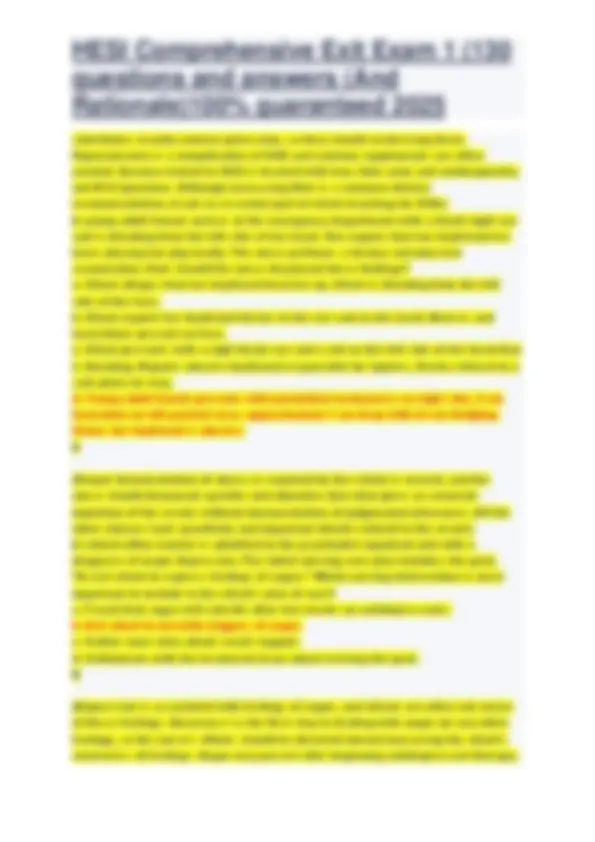
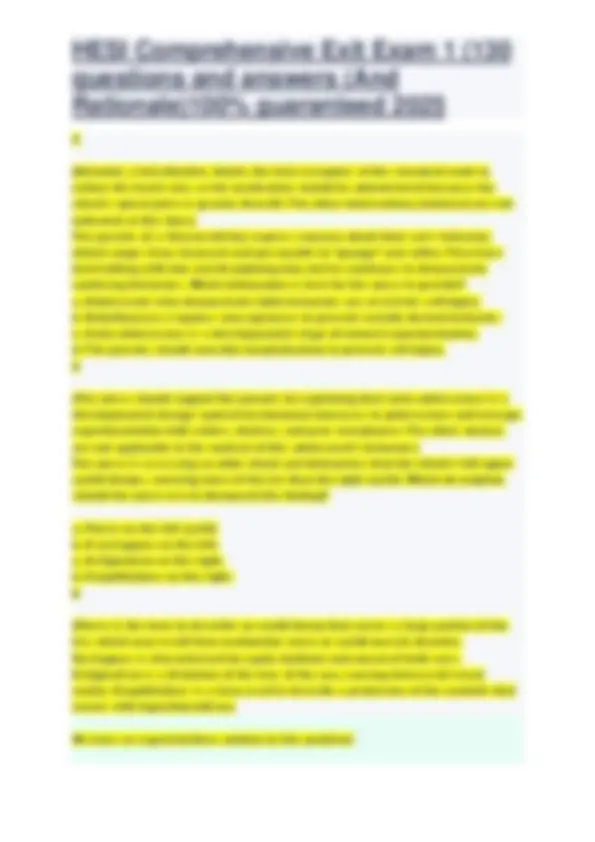
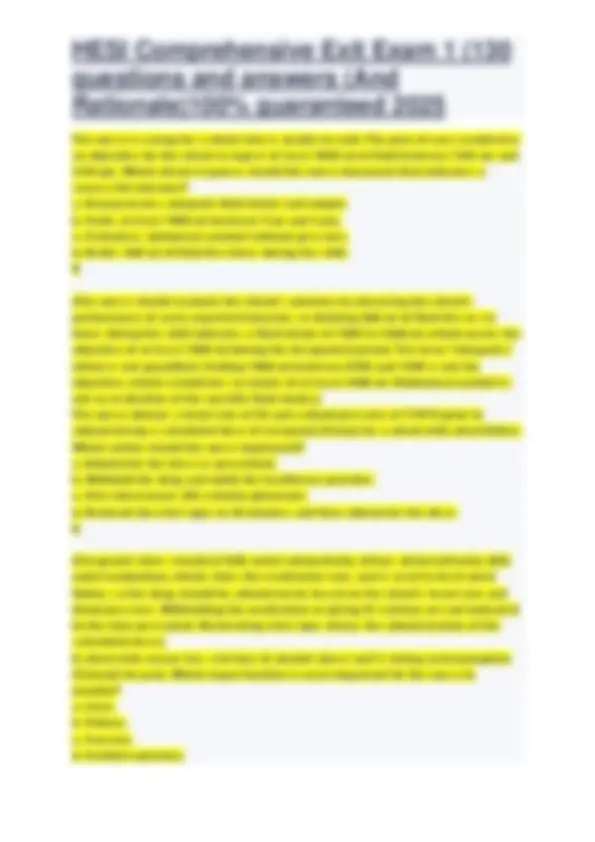
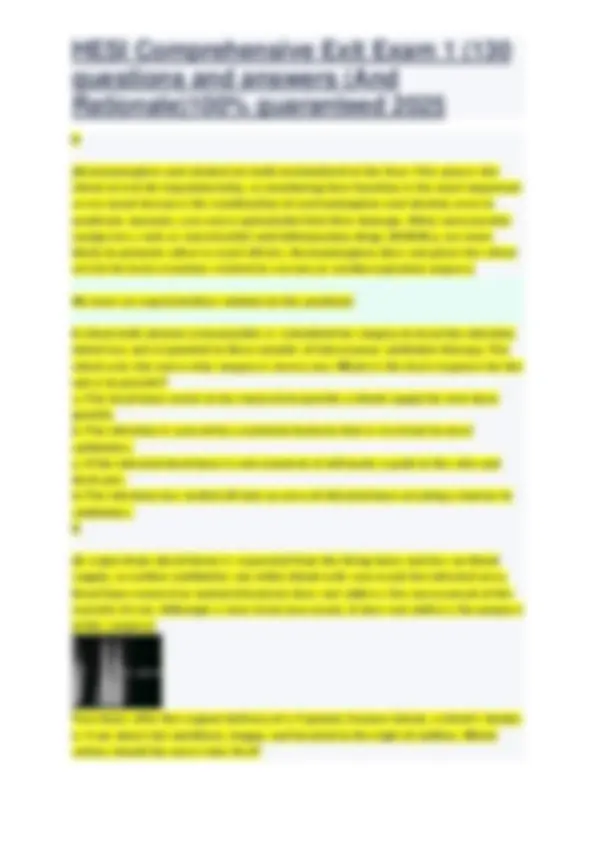
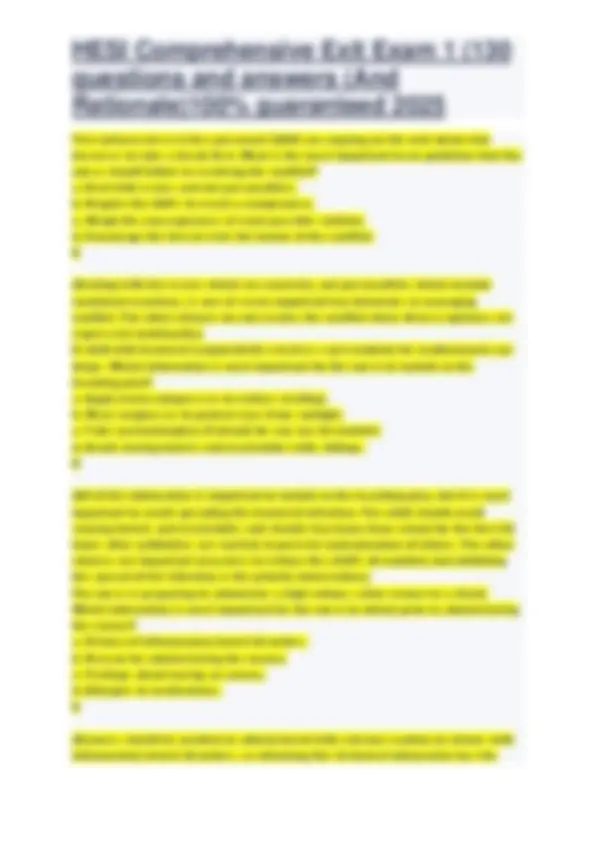
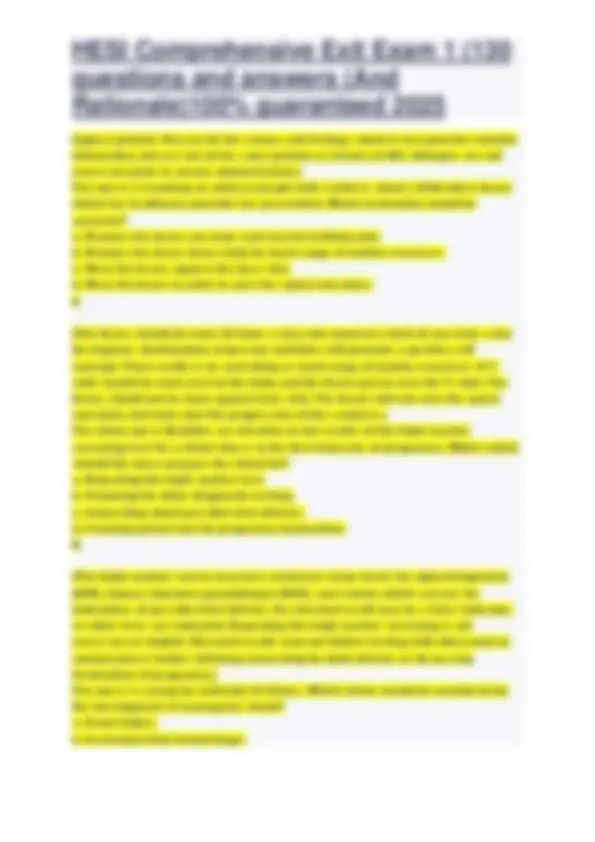
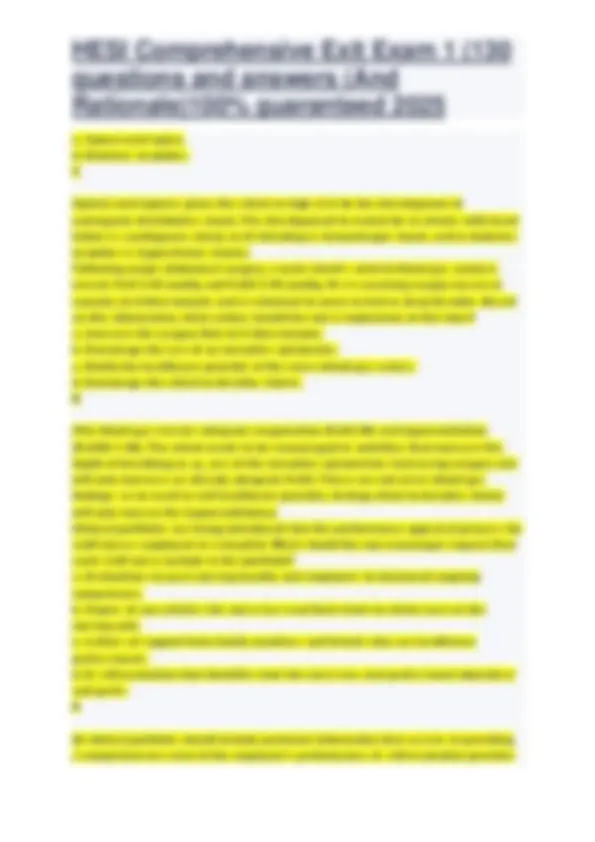
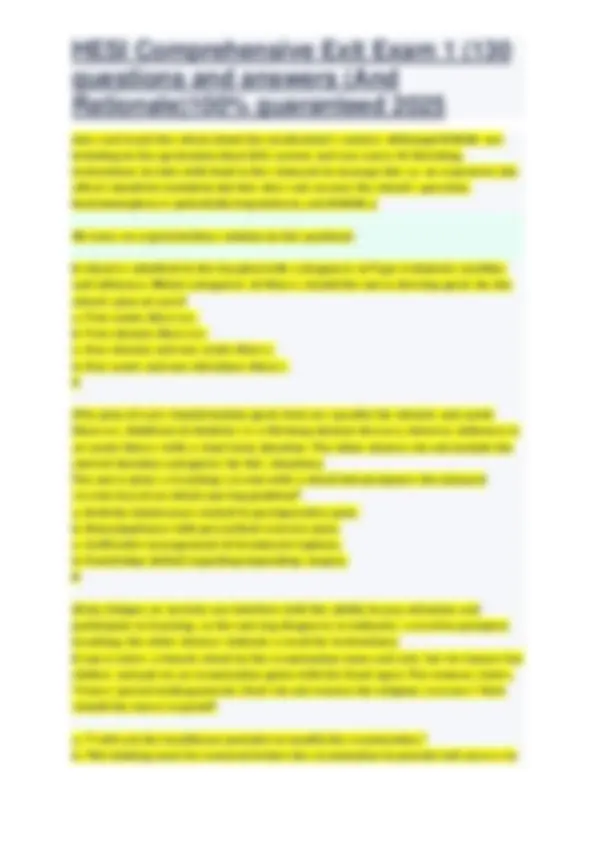
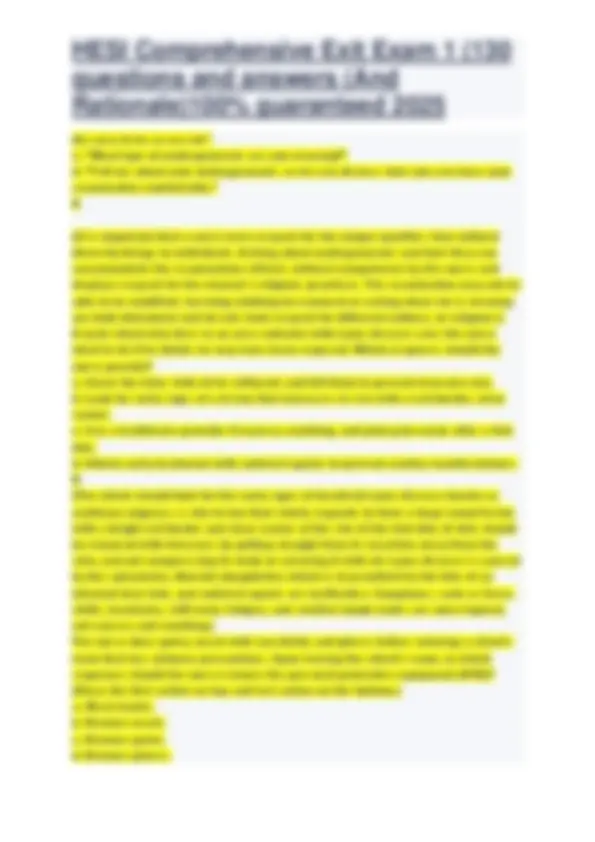
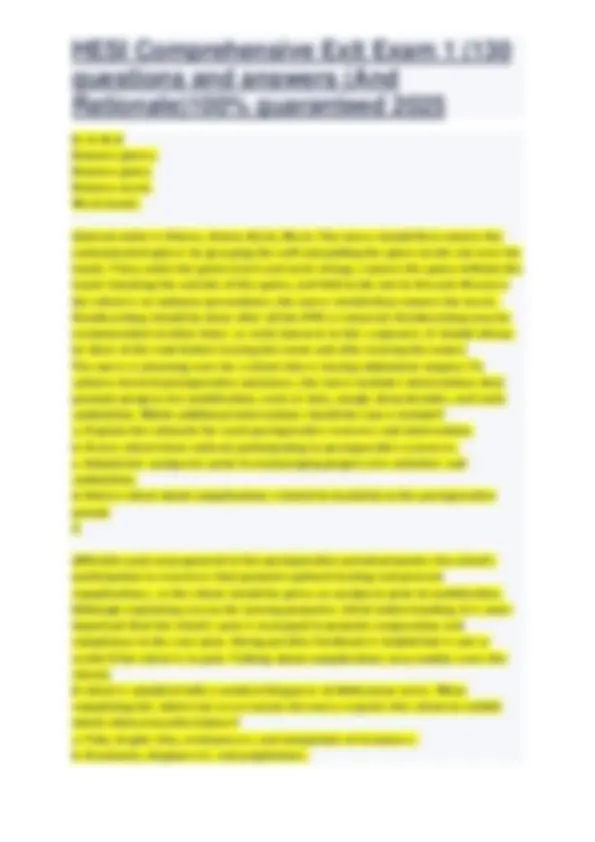
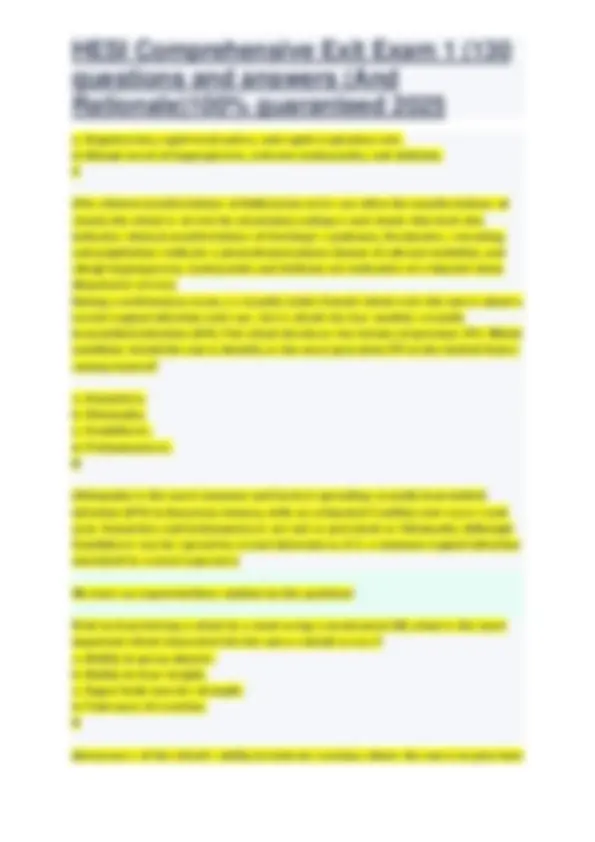
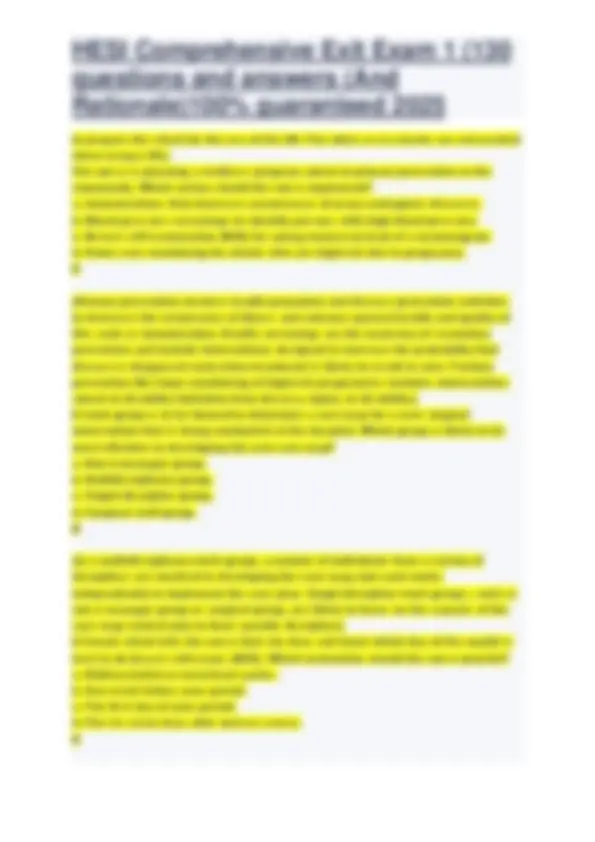
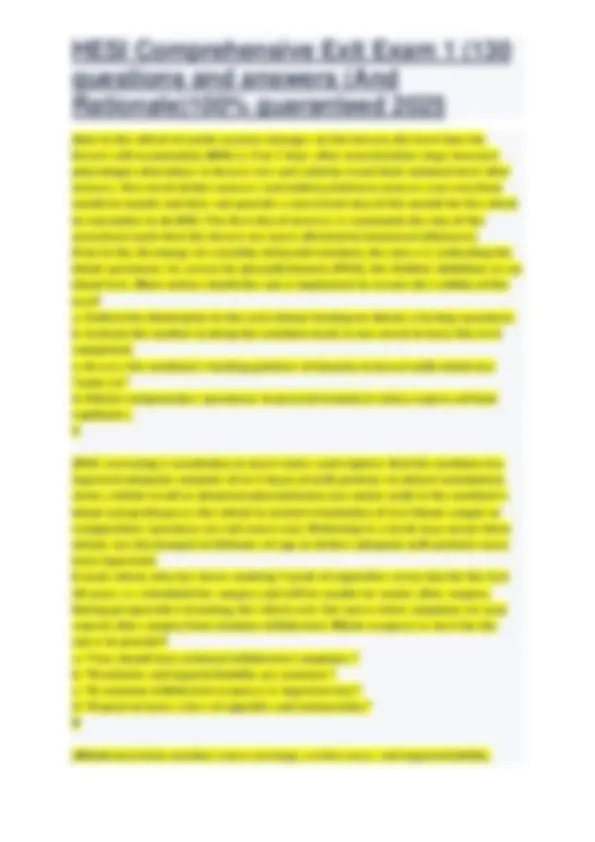
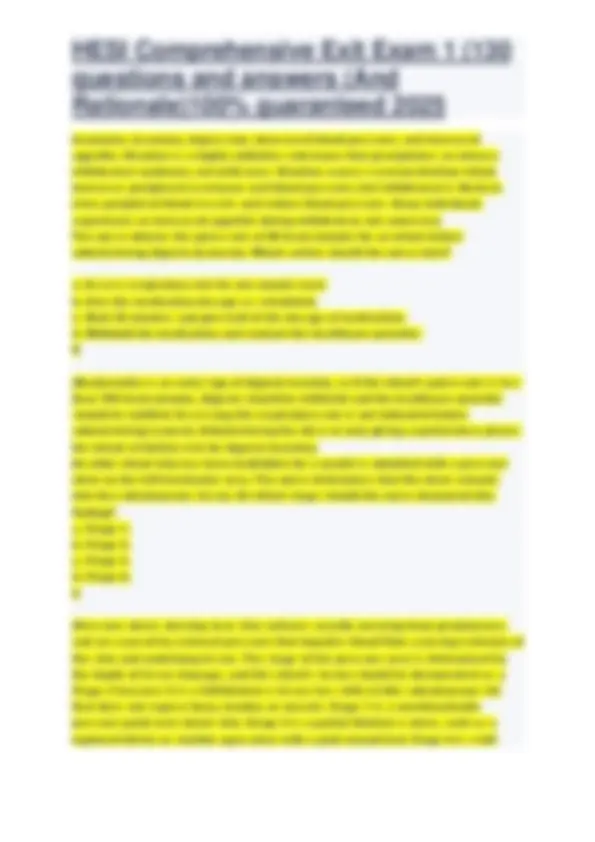
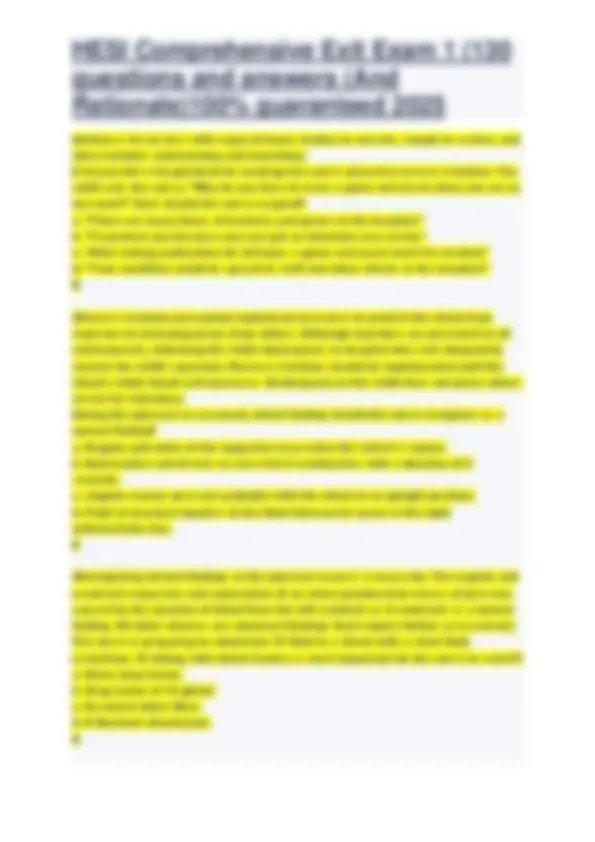
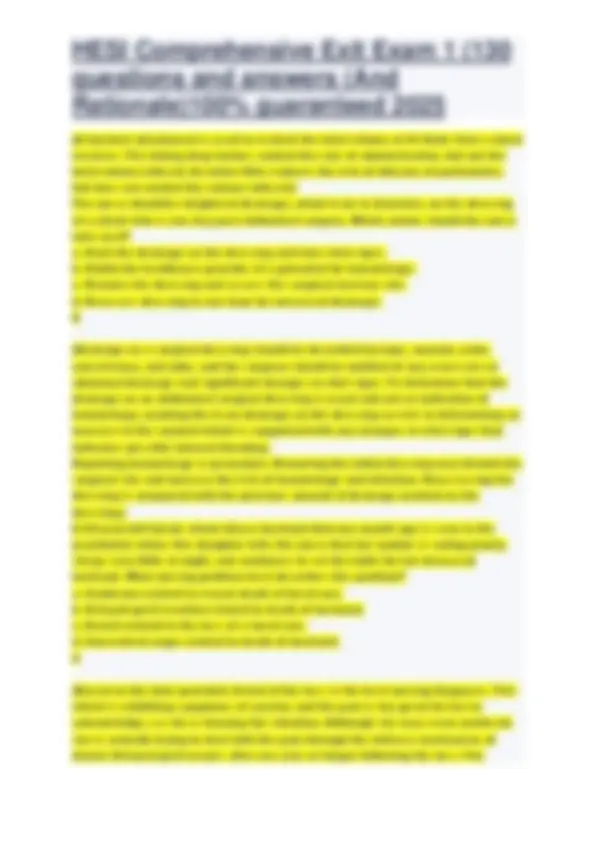
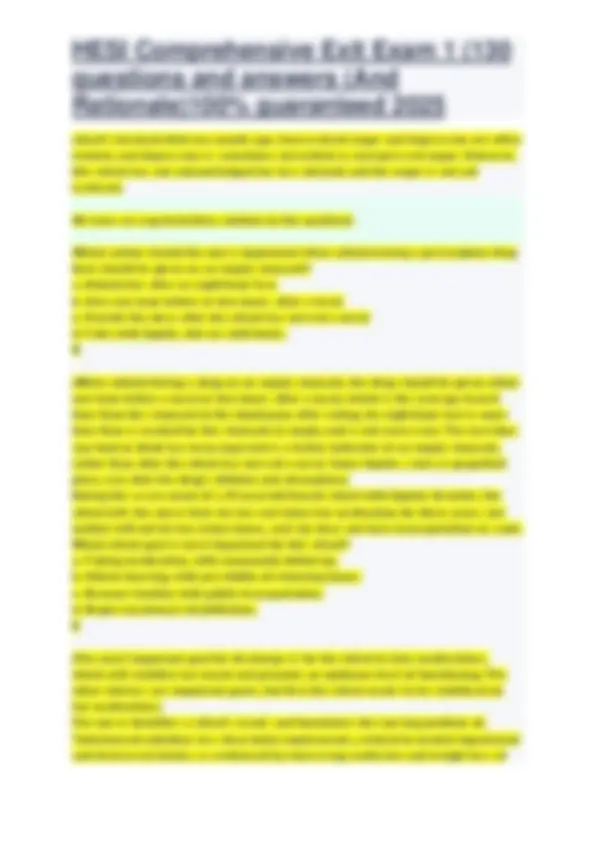
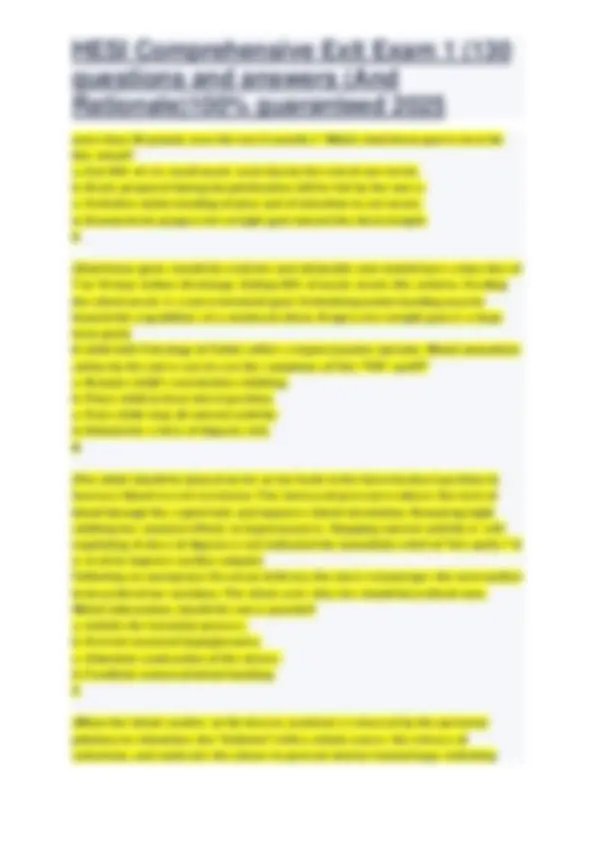
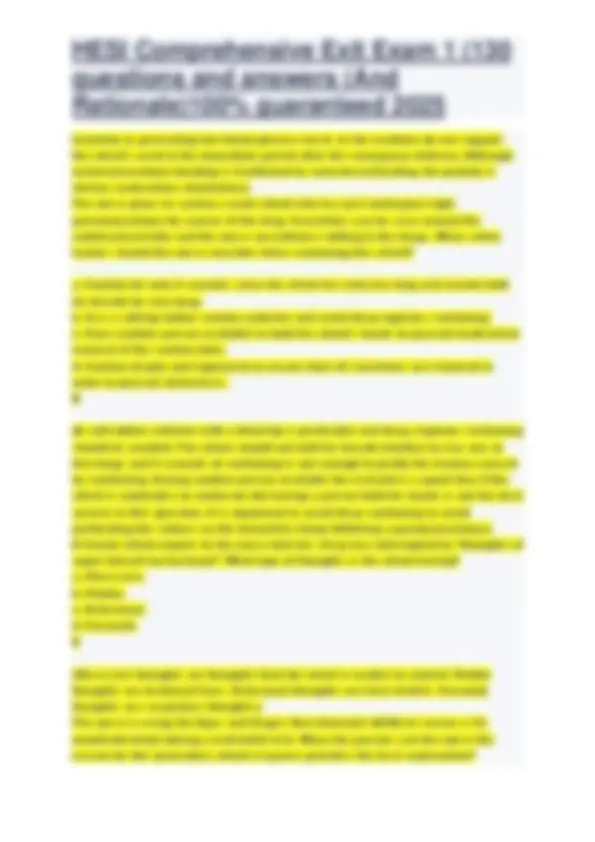
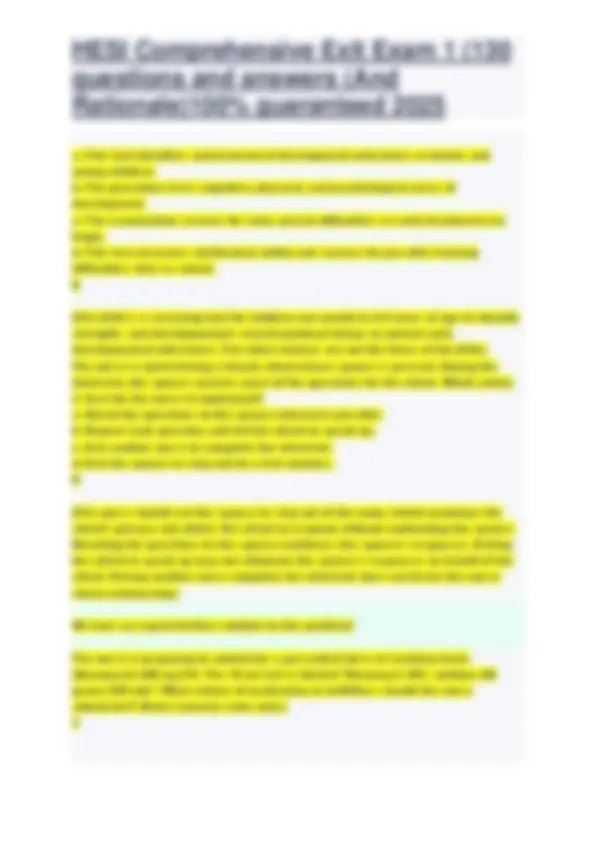
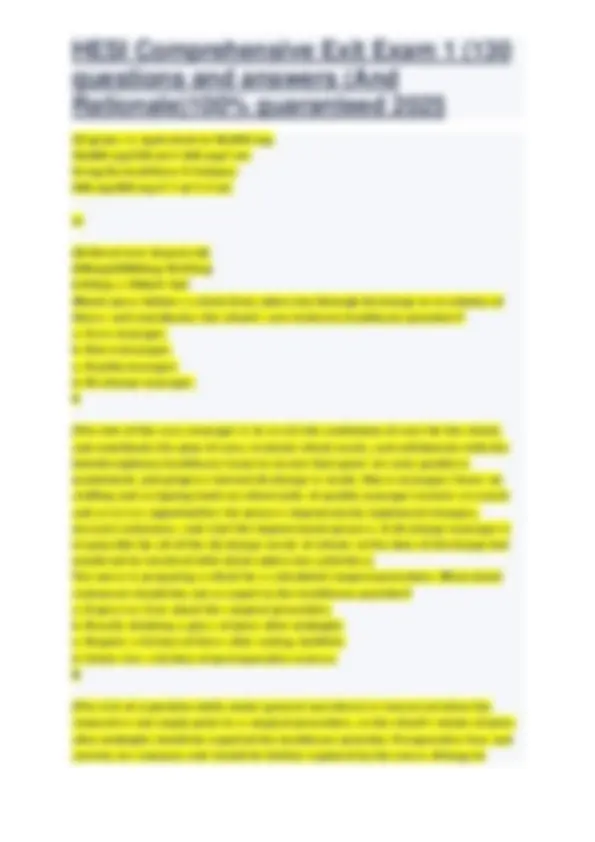
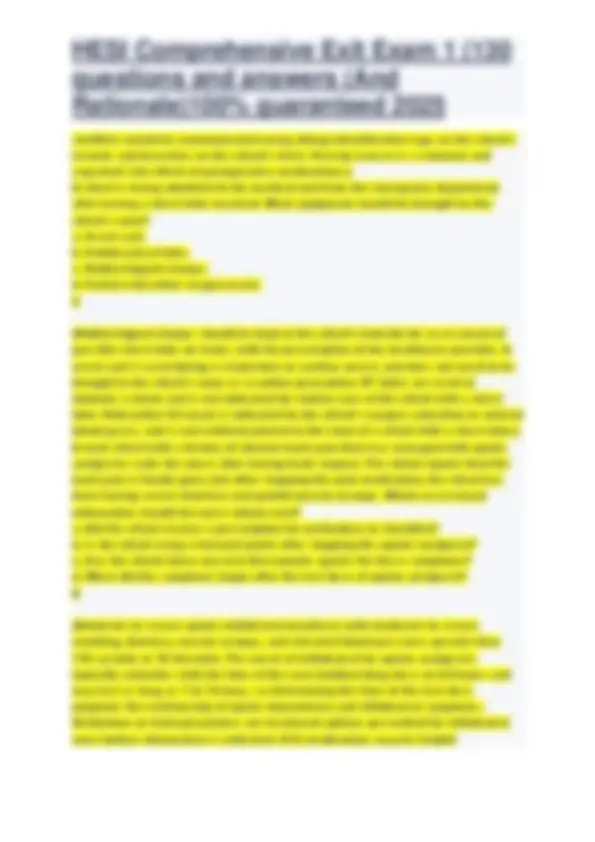
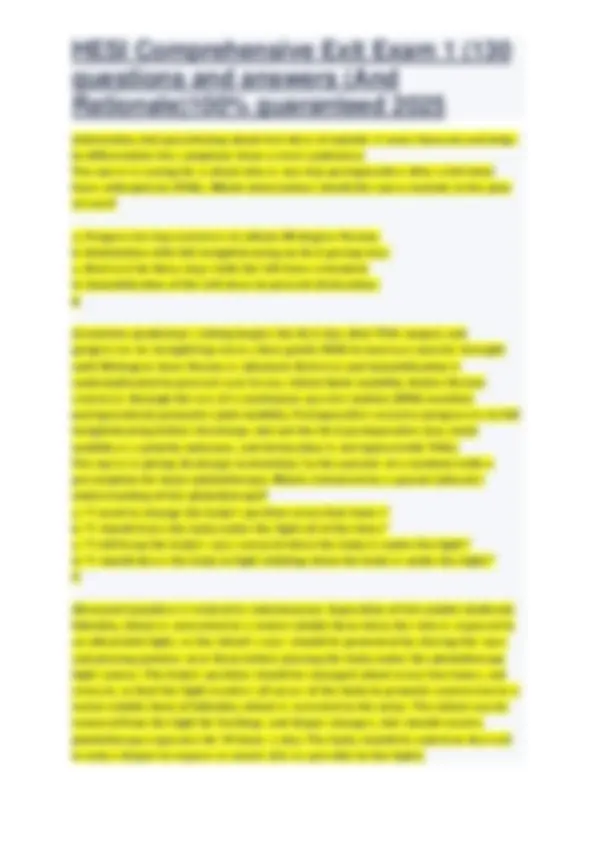
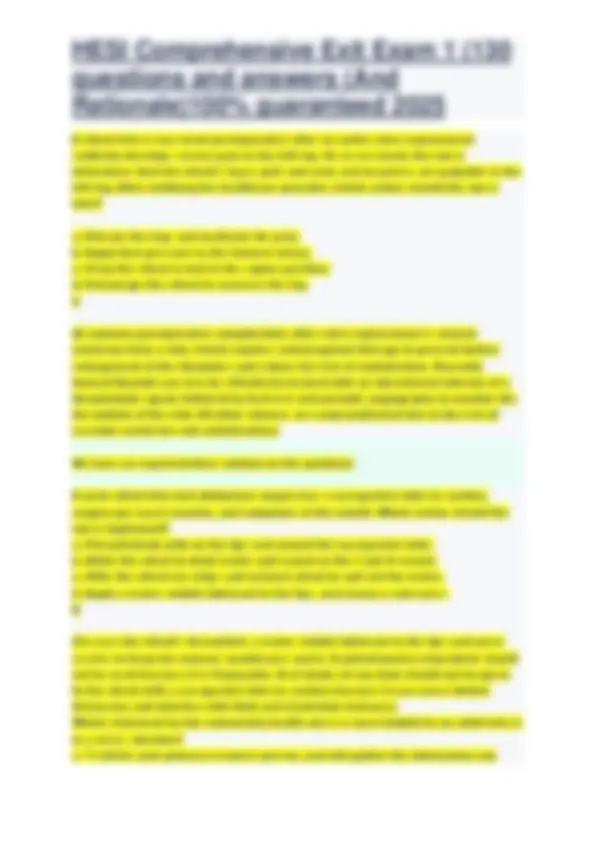
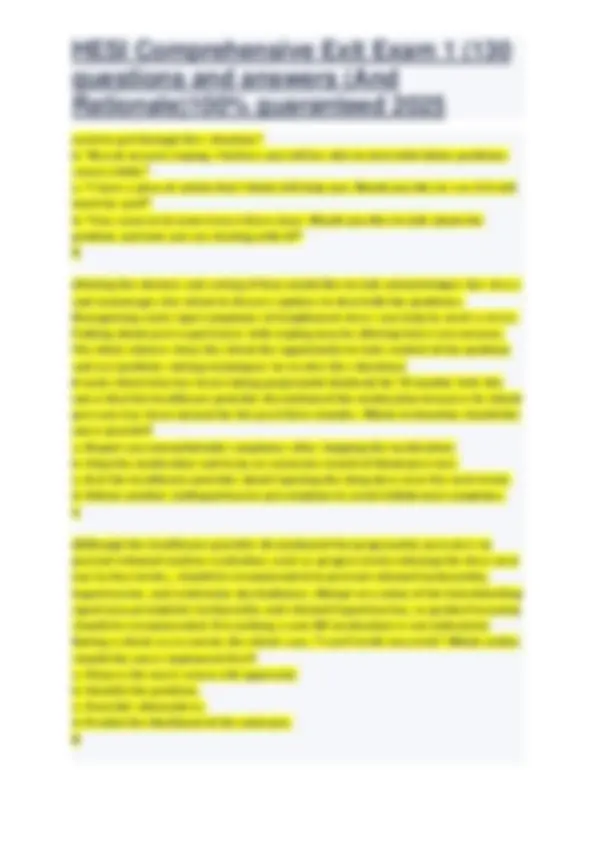
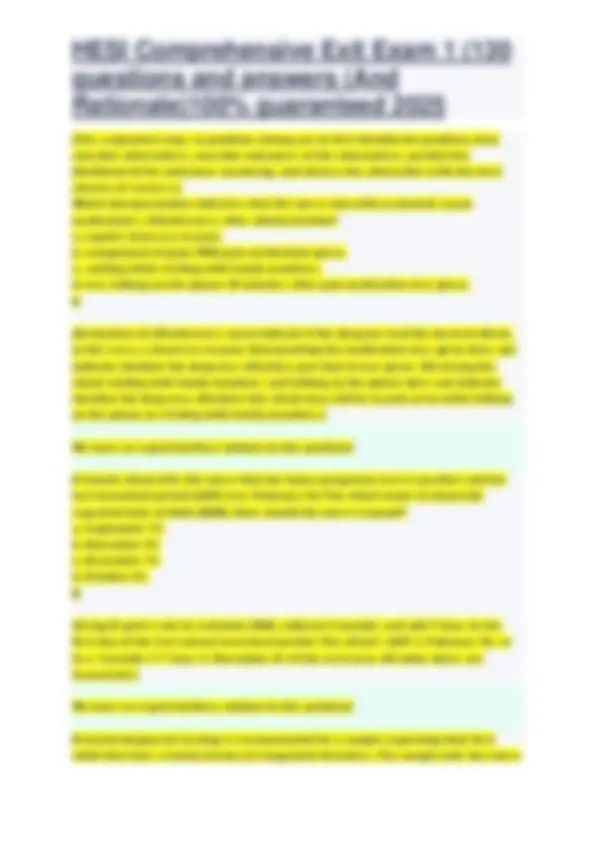
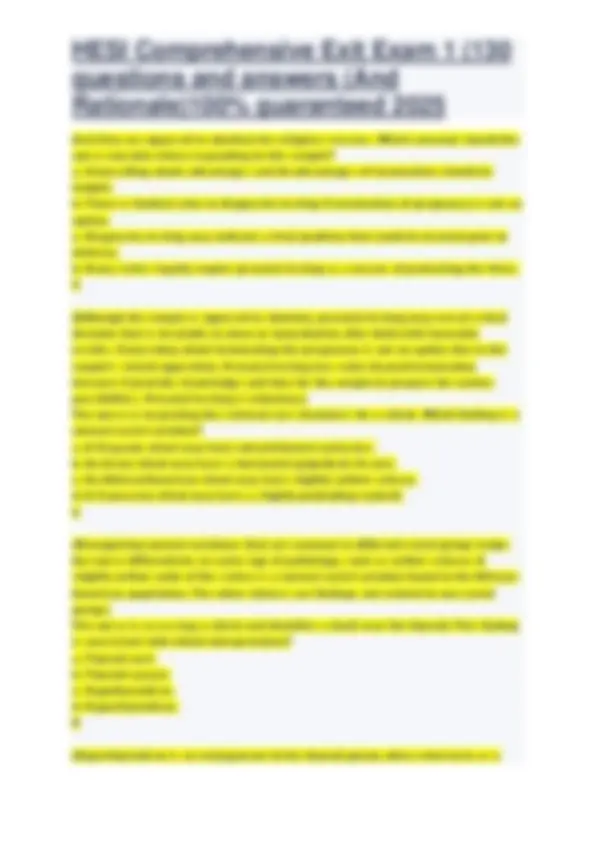
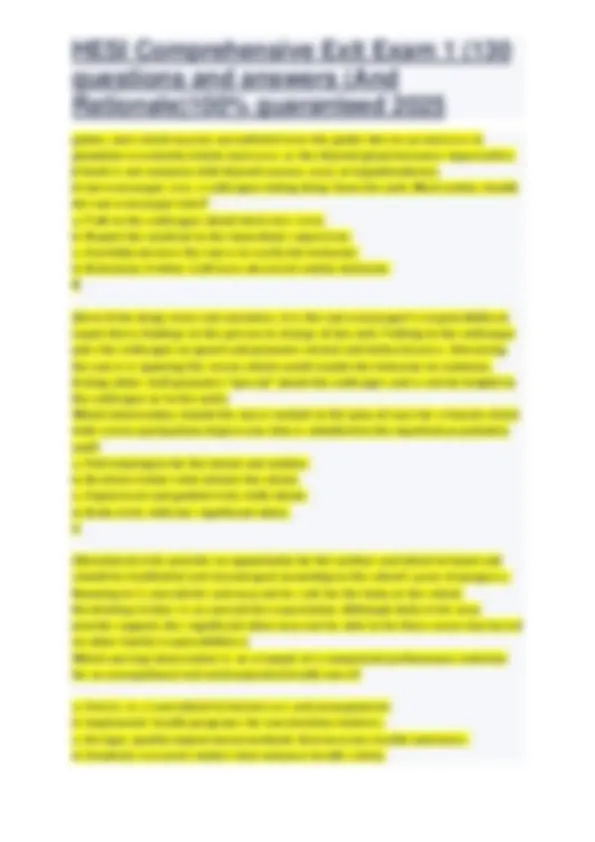
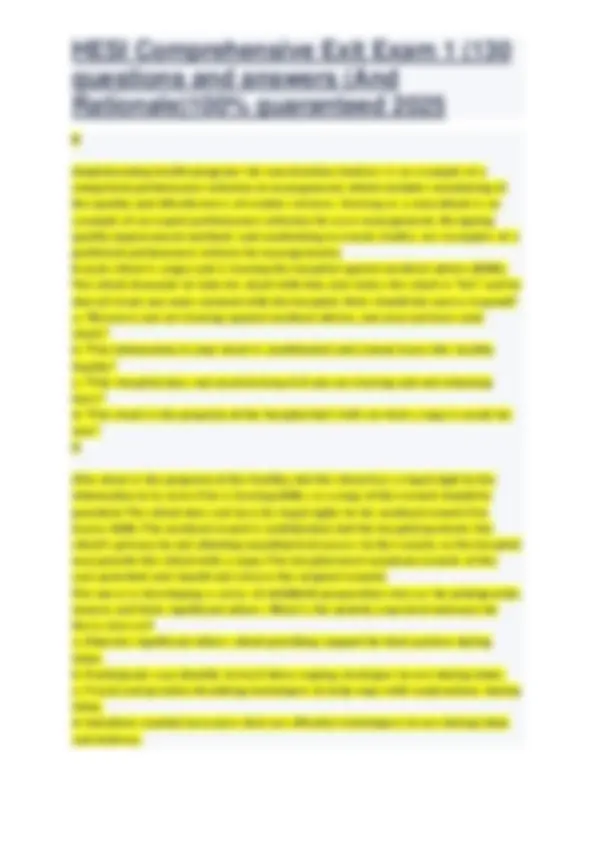
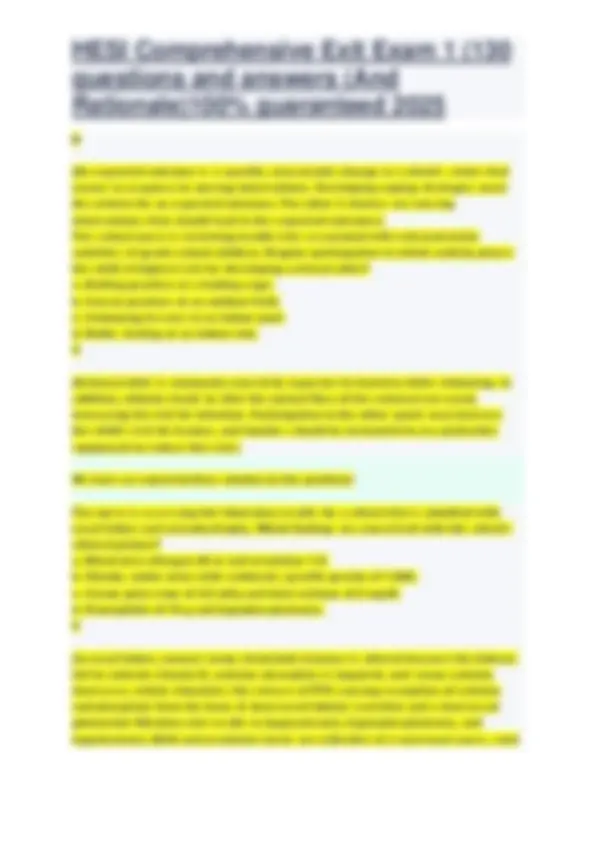
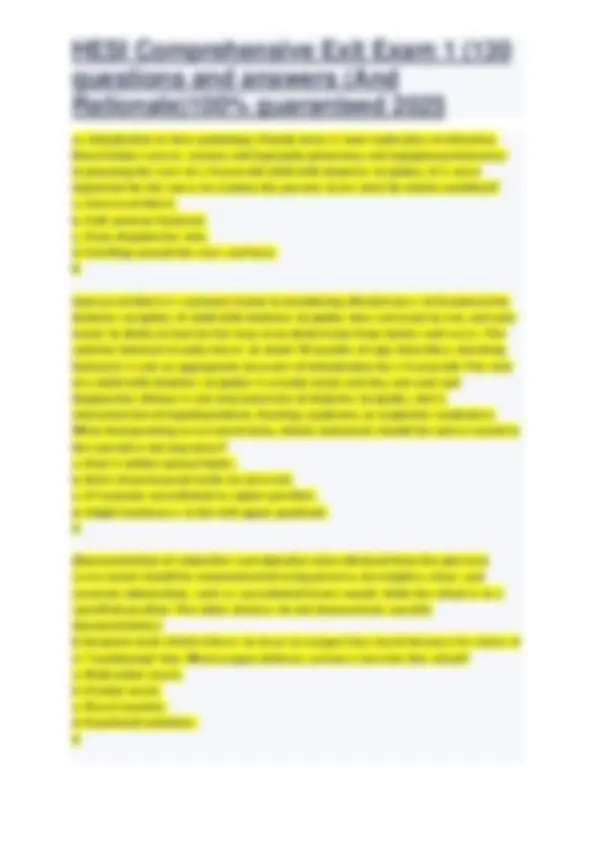
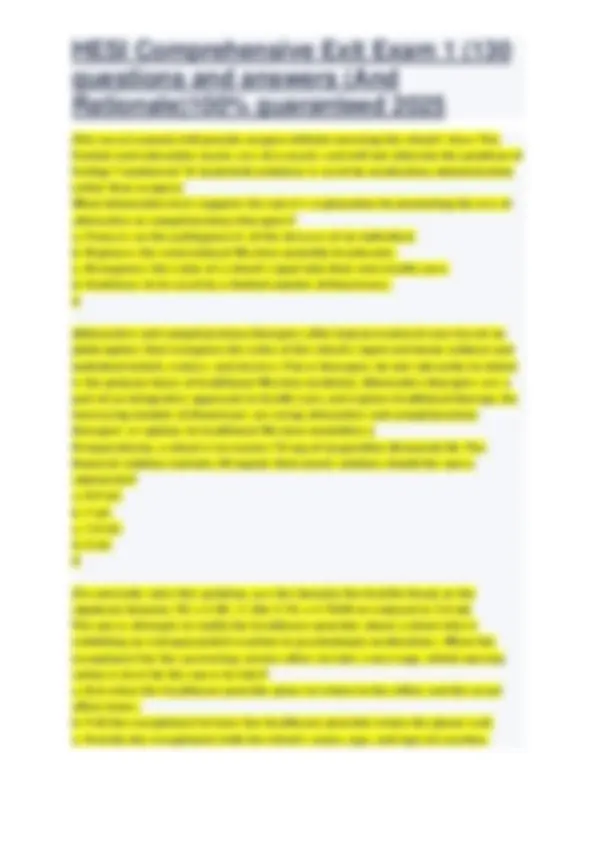
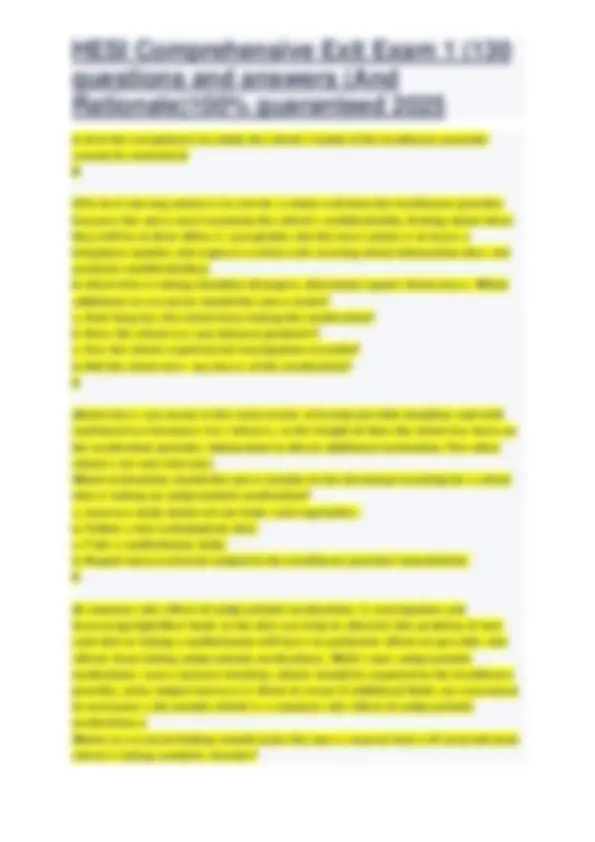
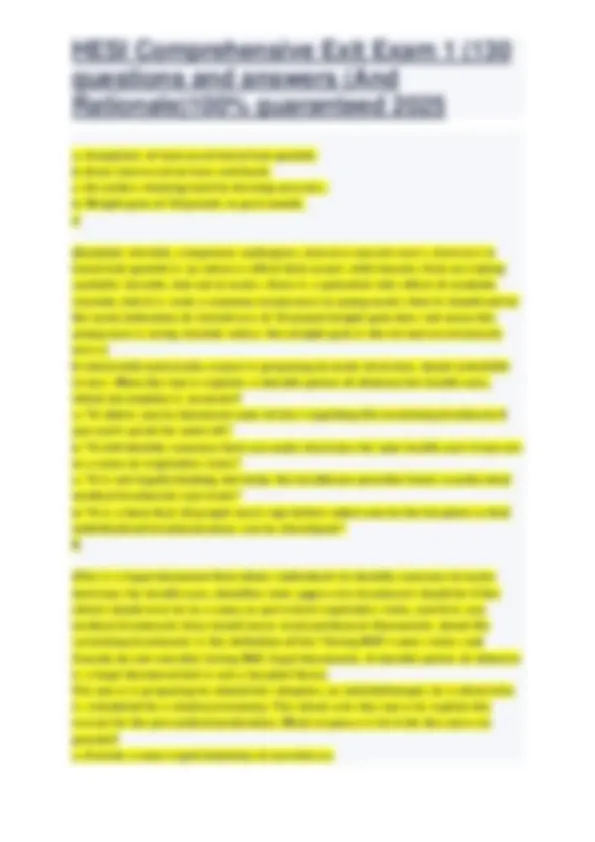
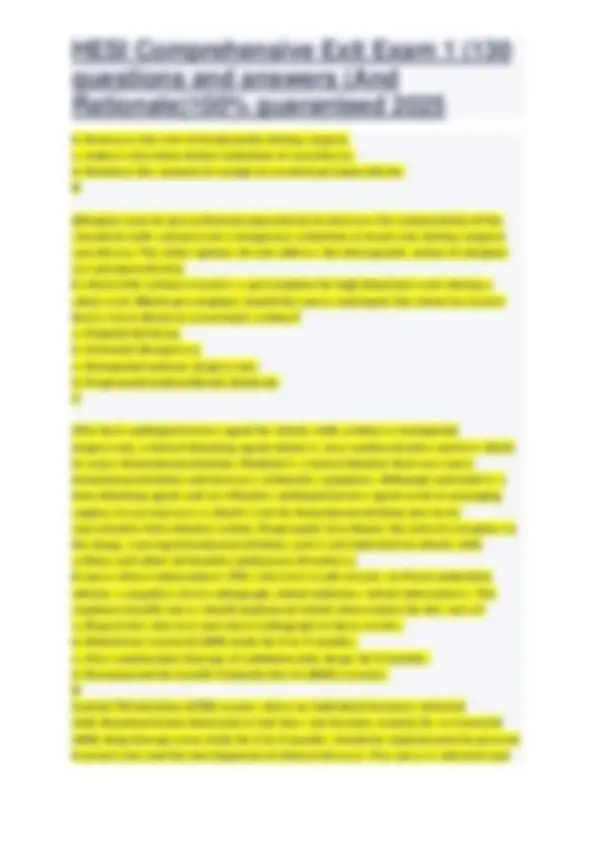
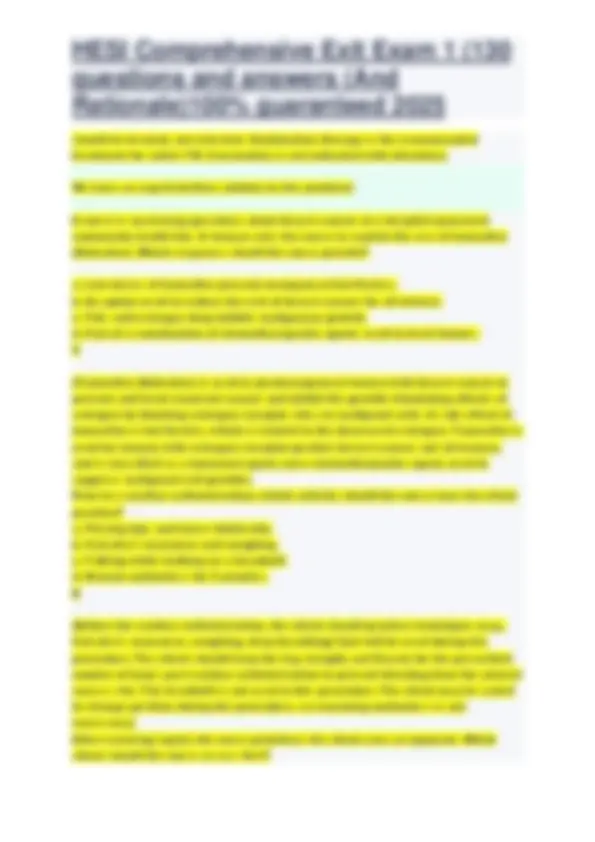
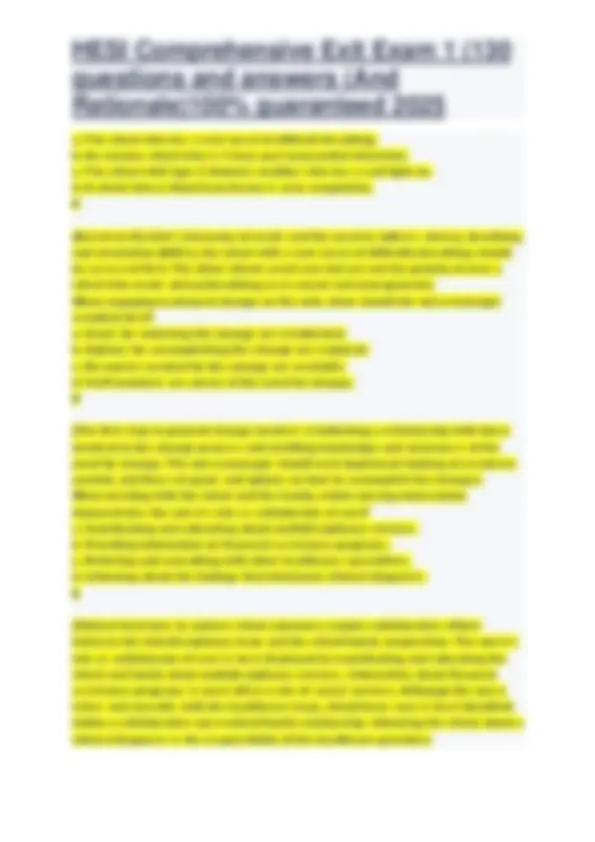
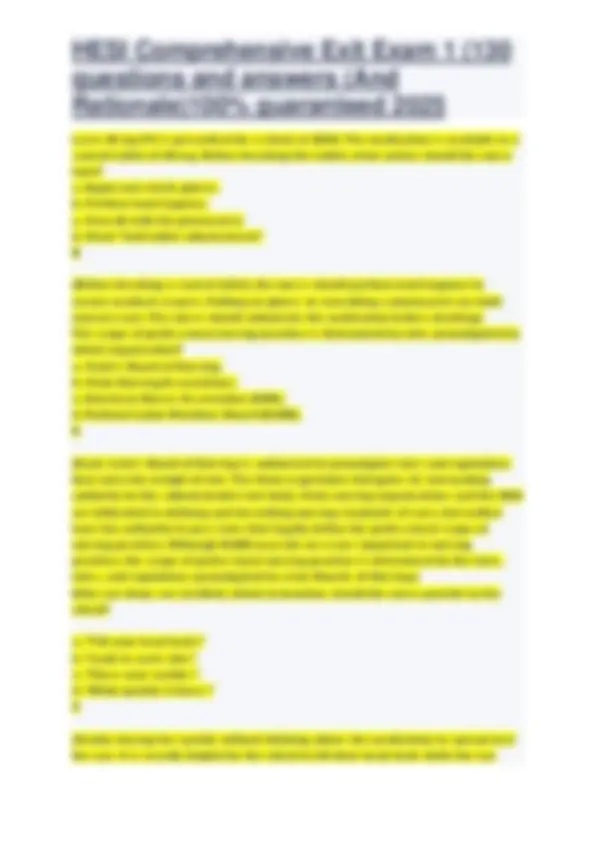
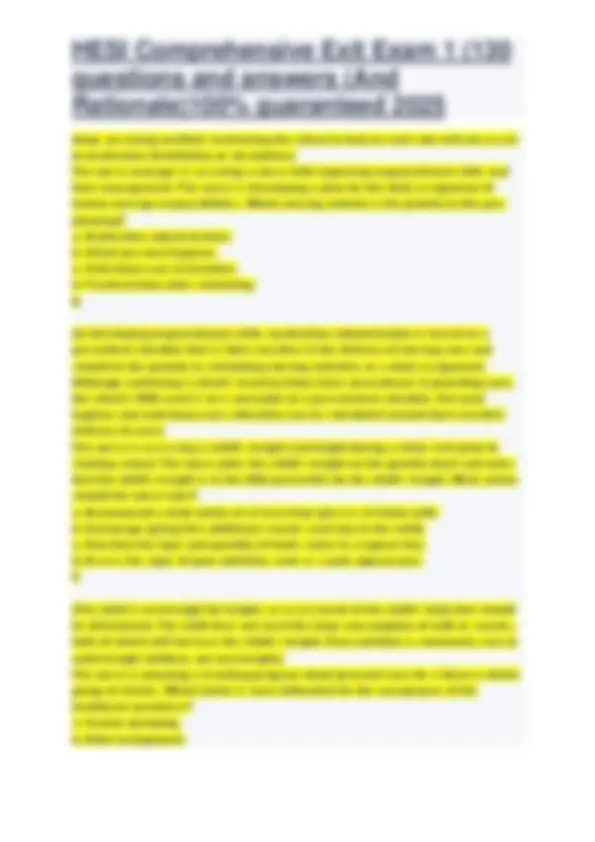
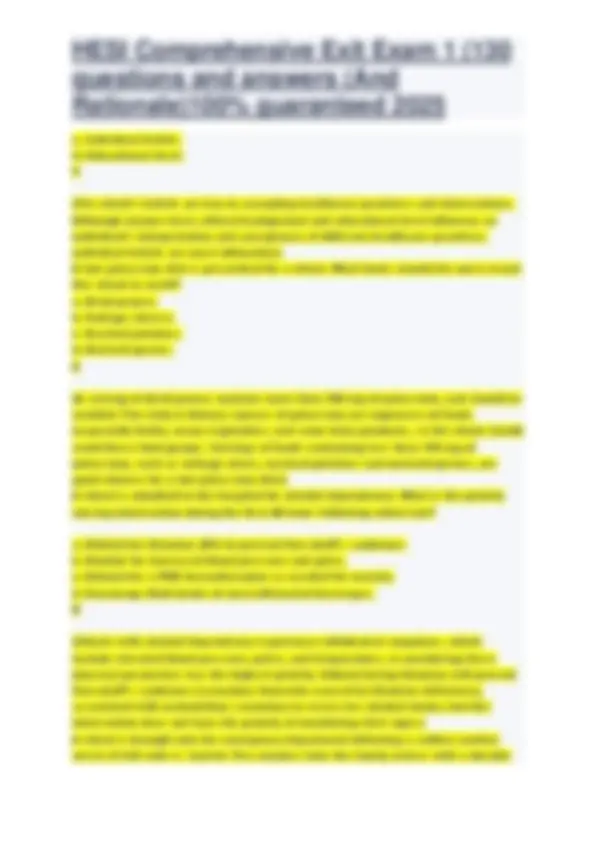
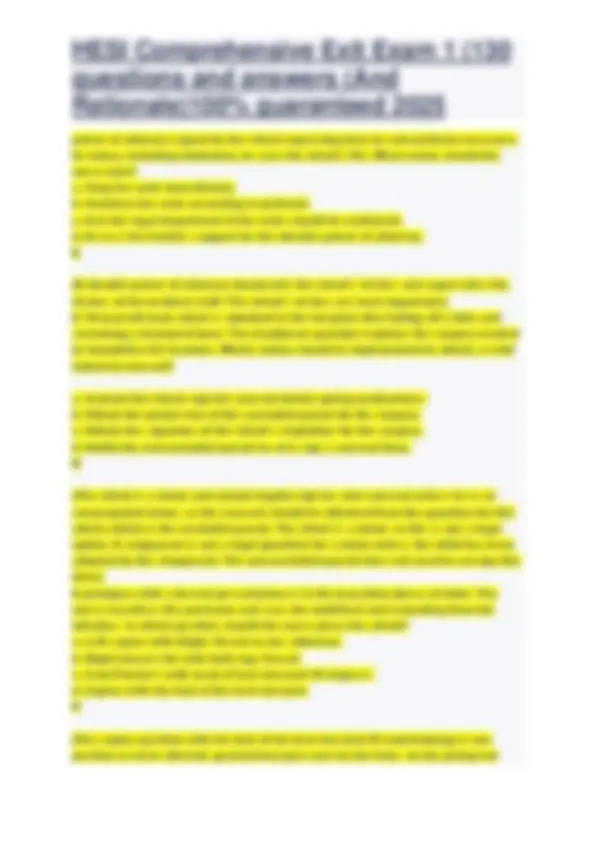
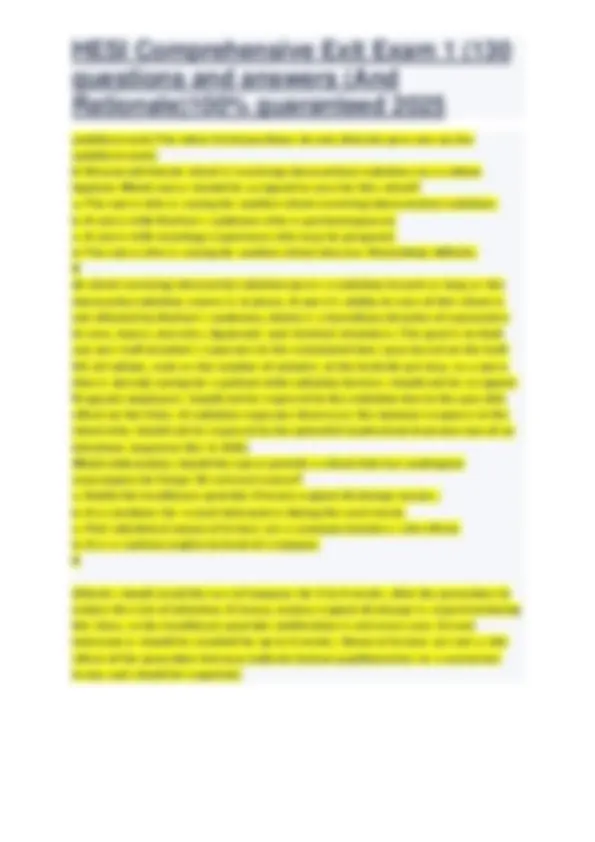


Study with the several resources on Docsity

Earn points by helping other students or get them with a premium plan


Prepare for your exams
Study with the several resources on Docsity

Earn points to download
Earn points by helping other students or get them with a premium plan
Community
Ask the community for help and clear up your study doubts
Discover the best universities in your country according to Docsity users
Free resources
Download our free guides on studying techniques, anxiety management strategies, and thesis advice from Docsity tutors
HESI Comprehensive Exit Exam 1 (125 questions and answers (And Rationale)100% guaranteed.pdf
Typology: Exams
1 / 52

This page cannot be seen from the preview
Don't miss anything!













































HESI Comprehensive Exit Exam 1 (130 questions and answers (And Rationale)100% guaranteed The nurse is monitoring neurological vital signs for a male client who lost consciousness after falling and hitting his head. Which assessment finding is the earliest and most sensitive indication of altered cerebral function? a. Unequal pupils. b. Loss of central reflexes. c. Inability to open the eyes. d. Change in level of consciousness. D (Neurological vital signs include serial assessments of TPR, blood pressure, and components of the Glasgow coma scale (GCS), which includes verbal, musculoskeletal, and pupillary responses. A change in the client's level of consciousness, as indicated by responses to commands during the GCS, is the first and the most sensitive sign of change in cerebral function. The other assessment data choices are late signs of altered cerebral function.) A nurse is planning to teach self-care measures to a female client about prevention of yeast infections. Which instructions should the nurse provide? a. Use a douche preparation no more than once a month. b. Increase daily intake of fiber and leafy green vegetables. c. Select nylon underwear that is loose-fitting, white, and comfortable. d. Avoid tight-fitting clothing and do not use bubble-bath or bath salts. D (A common genital tract infection in females is candidiasis, which is an overgrowth of the normal vaginal flora of Candida albicans that thrives in an environment that is warm and moist and is perpetuated by tight-fitting clothing, underwear, or pantyhose made of nonabsorbent materials. The client should wear clothing that is loose fitting and absorbent, such as cotton underwear, and avoid using bubble-bath or bath salts which further irritate sensitive genital tissue. Douching is not recommended because it can irritate vaginal tissue, alter pH, and contribute to fungal growth. While increasing dietary fiber intake encourages healthy, nutritional guidelines, it is not the focus of the teaching. Cotton, not nylon undergarments, provide absorbancy and reduce moisture in the perineal area.) Brainpower Read More
A client who has active tuberculosis (TB) is admitted to the medical unit. What action is most important for the nurse to implement? a. Place an isolation cart in the hallway. b. Fit the client with a respirator mask. c. Don a clean gown for client care. d. Assign the client to a negative air-flow room. D (Active tuberculosis requires implementation of airborne precautions, so the client should be assigned to a negative pressure air-flow room. Although isolation gowns and isolation carts should be implemented for clients in isolation with contact precautions, it is most important that air flow from the room is minimized when the client has TB. The respirator mask should be implemented when the client leaves the isolation environment.) The nurse is planning to conduct nutritional assessments and diet teaching to clients at a family health clinic. Which individual has the greatest nutritional and energy demands? a. A pregnant woman. b. A teenager beginning puberty. c. A 3-month-old infant. d. A school-aged child. A A pregnant woman's metabolic demands are 20 to 24% more than the basic metabolic rate. The other clients require only 15 to 20% more than the basic metabolic rate. What nursing delivery of care provides the nurse to plan and direct care of a group of clients over a 24-hour period? a. Team nursing. b. Primary nursing. c. Case management. d. Functional nursing. B (Primary nursing is a model of delivery of care where a nurse is accountable for planning care for clients around the clock. Functional nursing is a care delivery model that provides client care by assignment of functions or tasks. Team nursing is a care delivery model where assignments to a group of clients are provided by
A male client diagnosed with antisocial personality disorder is morbidly obese and is placed on a low fat, low calorie diet. At dinner the nurse notes that he is trying to get other clients on the unit to give him part of their meals. What intervention should the nurse implement? a. Remove the client from the table and have him sit alone. b. Send the client back to his room and do not allow him to eat. c. Report the behavior to the on-call psychologist immediately. d. Confront the client about the consequences of the behavior. D (The nurse should provide a reality check by helping the client realize that there are consequences to his behavior. Removing the client from the room or table does not help the client realize that his behavior is manipulative and harmful to himself as well as others. This behavior needs to be documented, but does not need to be reported immediately.) The nurse is assessing a client who complains of weight loss, racing heart rate, and difficulty sleeping. The nurse determines the client has moist skin with fine hair, prominent eyes, lid retraction, and a staring expression. These findings are consistent with which disorder? a. Grave's disease. b. Cushing syndrome. c. Multiple sclerosis. d. Addison's disease. A (This client is exhibiting symptoms associated with hyperthyroidism or Grave's disease, which is an autoimmune condition affecting the thyroid. Cushing syndrome, multiple sclerosis, or Addison's disease are not associated with these symptoms.) Which information should the nurse give a client with chronic kidney disease (CKD)? a. Restrict calcium-rich foods. b. Obtain monthly B12 injections. c. Avoid salt substitutes. d. Increase daily intake of fiber. C (A client with CKD should restrict sodium and potassium dietary intake, and salt
substitutes usually contain potassium, so they should avoid using them. Hypocalcemia is a complication of CKD and calcium supplements are often needed. Anemia related to CKD is treated with iron, folic acid, and erythropoietin, not B12 injections. Although increasing fiber is a common dietary recommendation, it not an essential part of client teaching for CKD.) A young adult female arrives at the emergency department with a black right eye and is bleeding from the left side of her head. She reports that her boyfriend has been abusing her physically. The nurse performs a history and physical examination. How should the nurse document these findings? a. Client alleges that her boyfriend beat her up. Client is bleeding from the left side of the face. b. Client reports her boyfriend hit her in the eye and on the head. Bruises and lacerations present on face. c. Client presents with a right black eye and a cut on the left side of her head that is bleeding. Reports abusive boyfriend responsible for injuries. Needs referral to a safe place to stay. d. Young adult female presents with periorbital ecchymosis on right side, 3 cm laceration on left parietal area, approximately 1 cm deep with tissue bridging. States her boyfriend is abusive. D (Proper documentation of abuse as reported by the victim is crucial, and the nurse should document specific and objective data that gives an accurate depiction of the events without documentation of judgmental inferences. All the other choices lack specificity and important details related to the event.) A retired office worker is admitted to the psychiatric inpatient unit with a diagnosis of major depression. The initial nursing care plan includes the goal, "Assist client to express feelings of anger." Which nursing intervention is most important to include in the client's plan of care? a. Teach that anger will subside after two weeks on antidepressants. b. Ask client to describe triggers of anger. c. Gather more data about social support. d. Collaborate with the treatment team about revising the goal. B (Depression is associated with feelings of anger, and clients are often not aware of these feelings. Awareness is the first step in dealing with anger (or any other feeling), so the nurse's efforts should be directed toward increasing the client's awareness of feelings. Anger may persist after beginning antidepressant therapy,
manifestations of a basilar skull fracture. What assessment finding would be consistent with a basilar skull fracture? a. Asymmetry of the face and eye movements. b. Abnormal position and movement of the arm. c. Hematemesis and abdominal distention. d. Rhinorrhoea or otorrhoea with Halo sign D Raccoon eyes (periorbital ecchymosis) and Battle's sign (ecchymosis behind the ear over the mastoid process are both signs of a basilar skull fracture, so the nurse should assess for possible meningeal tears that manifest as a Halo sign with CSF leakage from the ears or nose. Asymmetry of the face is consistent with orbital fractures. Abnormal position of arms occurs with wrenching traumas of the shoulder or arm fractures. Vomiting blood occurs with blunt abdominal injuries. The nurse is assessing a client and identifies the presence of petechiae. Which documentation best describes this finding? a. Purplish-red pinpoint lesions of the skin. b. Purple to bluish discoloration of the skin. c. Small circumscribed elevations containing purulent fluid. d. Generalized reddish discoloration of an area of skin. A (Petechiae are described as purplish to red, non-blanchable, pinpoint lesions that are tiny hemorrhages within the dermal or submucosal layers. Purplish skin discoloration describes ecchymosis caused by trauma to the underlying blood vessels. Small elevations containing pus describes pustules. Generalize red skin area is nonspecific and incomplete.) A client is receiving atenolol (Tenormin) 25 mg PO after a myocardial infarction. The nurse determines the client's apical pulse is 65 beats per minute. What action should the nurse implement next? a. Notify the healthcare provider. b. Measure the blood pressure. c. Administer the medication. d. Reassess the apical pulse.
(Atenolol, a beta-blocker, blocks the beta receptors of the sinoatrial node to reduce the heart rate, so the medication should be administered because the client's apical pulse is greater than 60. The other interventions [choices] are not indicated at this time.) The parents of a 14-year-old boy express concern about their son's behavior, which ranges from clean-cut and personable to "grungy" and sullen. They have tried talking with him and disciplining him, but he continues to demonstrate confusing behaviors. Which information is best for the nurse to provide? a. Adolescents who demonstrate labile behaviors are at risk for self-injury. b. Rebelliousness requires consequences to prevent socially deviant behavior. c. Early adolescence is a developmental stage of normal experimentation. d. The parents should consider hospitalization to prevent self injury. C (The nurse should support the parents by explaining that early adolescence is a developmental change spurred by hormonal increases in pubescence and teenage experimentation with values, choices, and peer acceptance. The other choices are not applicable in the context of this adolescent's behavior.) The nurse is assessing an older client and determines that the client's left upper eyelid droops, covering more of the iris than the right eyelid. Which description should the nurse use to document this finding? a. Ptosis on the left eyelid. b. A nystagmus on the left. c. Astigmatism on the right. d. Exophthalmos on the right. A (Ptosis is the term to describe an eyelid droop that covers a large portion of the iris, which may result from oculomotor nerve or eyelid muscle disorder. Nystagmus is characterized by rapid, rhythmic movement of both eyes. Astigmatism is a distortion of the lens of the eye, causing decreased visual acuity. Exophthalmos is a term used to describe a protrusion of the eyeballs that occurs with hyperthyroidism.) We have an expert-written solution to this problem!
(Acetaminophen and alcohol are both metabolized in the liver. This places the client at risk for hepatotoxicity, so monitoring liver function is the most important assessment because the combination of acetaminophen and alcohol, even in moderate amounts, can cause potentially fatal liver damage. Other non-narcotic analgesics, such as nonsteroidal anti-inflammatory drugs (NSAIDs), are more likely to promote adverse renal effects. Acetaminophen does not place the client at risk for toxic reactions related to sensory or cardiorespiratory organs.) We have an expert-written solution to this problem! A client with chronic osteomyelitis is scheduled for surgery to treat the infection which has not responded to three months of intravenous antibiotic therapy. The client asks the nurse why surgery is necessary. Which is the best response for the nurse to provide? a. The dead bone needs to be removed to provide a blood supply for new bone growth. b. The infection is caused by a mutated bacteria that is resistant to most antibiotics. c. If the infected dead bone is not removed, it will make a path to the skin and drain pus. d. The infection has walled off into an area of infected bone creating a barrier to antibiotics. D (A sequestrum (dead bone) is separated from the living bone and has no blood supply, so neither antibiotics nor white blood cells can reach the infected area. Dead bone removal or mutated bacteria does not address the encasement of the necrotic tissue. Although a sinus tract may occur, it does not address the purpose of the surgery.) Two hours after the vaginal delivery of a 7-pound, 3-ounce infant, a client's fundus is 3 cm above the umbilicus, boggy, and located to the right of midline. Which action should the nurse take first?
a. Massage the uterine fundus. b. Palpate above the symphysis for the bladder. c. Perform bi-manual massage. d. Inspect the perineum for excessive bleeding. B (Two hours after giving birth, the uterus should be firm, in the midline, and below the umbilicus. If the fundus is high, dextroverted and boggy, urinary retention is likely distending the bladder, so palpating for a full bladder above the symphysis should be implemented first. The other choices should be implemented after the client voids or the bladder is emptied by catheterization.) After one month of short-term corticosteroid therapy, a client with an acute exacerbation of rheumatoid arthritis returns to the clinic for a follow-up visit. Which laboratory finding should the nurse review for a therapeutic response? a. Fasting serum glucose. b. Serum liver function test. c. Serum electrolyte levels. d. Erythrocyte sedimentation rate. D (An elevated erythrocyte sedimentation rate (ESR) is indicative of active inflammation, so the nurse should determine if the ESR has normalized. Although corticosteroids influence glucose metabolism, an elevation in serum glucose may indicate a side-effect response to exogenous corticosteroids, not a desired effect. Liver function and serum electrolyte levels do not indicate a therapeutic response to the corticosteroid therapy.) The nurse is conducting a drug education class for junior high school students. Which statement, provided by one of the student participants, best describes the primary characteristic of addiction? a. "Addicts who use illegal drugs are trying to escape reality." b. "Addiction causes people to steal and lie." c. "Those who are unhappy with themselves are more likely to become addicts." d. "Wanting the drug is all that matters to an addict." D (The hallmark characteristic of addiction is impaired control: all that matters is obtaining the drug of choice. Trying to escape reality may or may not be true, but is not the primary characteristic of addiction. Stealing/lying to get the drug is a
Two unlicensed assistive personnel (UAP) are arguing on the unit about who deserves to take a break first. What is the most important basic guideline that the nurse should follow in resolving the conflict? a. Deal with issues and not personalities. b. Require the UAPs to reach a compromise. c. Weigh the consequences of each possible solution. d. Encourage the two to view the humor of the conflict. A (Dealing with the issues which are concrete, not personalities which include emotional reactions, is one of seven important key behaviors in managing conflict. The other choices do not resolve the conflict when diverse opinions are expressed emotionally.) A child with bacterial conjunctivitis receives a prescription for erythromycin eye drops. Which information is most important for the nurse to include in the teaching plan? a. Apply warm compresses to reduce swelling. b. Wear sunglasses to protect eyes from sunlight. c. Take acetaminophen (Tylenol) for any eye discomfort. d. Avoid sharing towels and washcloths with siblings. D (All of the information is important to include in the teaching plan, but it is most important to avoid spreading the bacterial infection. The child should avoid sharing towels and washcloths and should stay home from school for the first 24 hours after antibiotics are started, to prevent contamination of others. The other choices are important measures to reduce the child's discomfort, but inhibiting the spread of the infection is the priority intervention.) The nurse is preparing to administer a high volume saline enema to a client. Which information is most important for the nurse to obtain prior to administering the enema? a. History of inflammatory bowel disorders. b. Reason for administering the enema. c. Feelings about having an enema. d. Allergies to medications. A (Enemas should be avoided or administered with extreme caution to clients with inflammatory bowel disorders, so obtaining this historical information has the
highest priority. Reason for the enema and feelings about it also provide valuable information, but are not of the same priority as history of IBS. Allergies are not necessary prior to enema administration.) The nurse is teaching an adolescent girl with scoliosis about a Milwaukee brace which her healthcare provider has prescribed. Which instruction would be accurate? a. Remove the brace one hour each day for bathing only. b. Remove the brace twice daily for back range of motion exercises. c. Wear the brace against the bare skin. d. Wear the brace in order to cure the spinal curvature. A (The brace should be worn 23 hours a day and removed a total of one hour a day for hygiene. Continuation of present activities will promote a positive self concept. There really is no such thing as back range of motion exercises. A T- shirt should be worn next to the body and the brace put on over the T-shirt. The brace should not be worn against bare skin. The brace will not cure the spinal curvature, but only slow the progression of the scoliosis.) The clinic nurse identifies an elevation in the results of the triple marker screening test for a client who is in the first trimester of pregnancy. Which action should the nurse prepare the client for? a. Repeating the triple marker test. b. Preparing for other diagnostic testing. c. Counseling about possible fetal defects. d. Securing permission for pregnancy termination. B (The triple marker screen measures maternal serum levels for alpha-fetoprotein (AFP), human chorionic gonadotropin (HCG), and estriol, which screens for indications of possible fetal defects. An elevated result may be a false indicator, so other tests are indicated. Repeating the triple marker screening is not necessary or helpful. Elevated results warrant further testing with ultrasound or amniocentesis before initiating counseling for birth defects or discussing termination of pregnancy.) The nurse is caring for critically ill clients. Which client should be monitored for the development of neurogenic shock? a. Heart failure. b. Gastrointestinal hemorrhage.
an important assessment of the nurse's strengths, weaknesses, and progress toward the achievement of professional goals. Past evaluations not pertinent nor useful evaluative data regarding current performance. While documentation of continuing education and any certifications achieved are important to include in a clinical portfolio, copies of articles read is not necessary. Letters of support are not a significant component of a clinical portfolio.) An 80-year-old client is given morphine sulphate for postoperative pain. Which concomitant medication should the nurse question that poses a potential development of urinary retention in this geriatric client? a. Insulin. b. Antacids. c. Tricyclic antidepressants. d. Nonsteroidal antiinflammatory agents. C (Drugs with anticholinergic properties, such as tricyclic antidepressants, can exacerbate urinary retention associated with opioids in the older client. Although tricyclic antidepressants and antihistamines with opioids can exacerbate urinary retention, the concurrent use of insulin or antacids with opioids do not. Nonsteroidal antiinflammatory agents can increase the risk for bleeding, but do not increase urinary retention with opioids.) We have an expert-written solution to this problem! The nurse is teaching staff in a long-term facility home the principles of caring for clients with essential hypertension. Which comment should the nurse include in the inservice presentation about the care of clients with hypertension? a. "Clients with an elevated blood pressure often exhibit a stiff neck and are diaphoretic." b. "As long as clients receive daily antihypertensive medications, no further interventions are needed." c. "Caregivers should only conduct blood pressure checks under a registered nurse's direct supervision." d. "Frequent blood pressure checks, including readings taken by automated machines, are recommended." D
(Frequent blood pressure checks are recommended for hypertensive clients to evaluate the effectiveness of treatment. Symptoms such as a stiff neck are not typical of essential hypertension, which is an asymptomatic disease. Treatment usually includes dietary modifications and exercise, which should not be discontinued when medications are added to the treatment plan. While the RN is ultimately responsible for the assessment of blood pressures, caregivers are not restricted from obtaining the blood pressure readings.) To assess a client's pupillary response to accommodation, a nurse should perform which activity? a. Cover one eye for one minute and note the pupil reaction when the cover is removed. b. Shine a light into the client's eye and watch the pupil response in the opposite eye. c. Touch the cornea with a piece of sterile cotton and observe for a change in pupil size. d. Ask the client to look at a distant object and then at an object held 10 cm from the nose. D (To check the accommodation response, the client should gaze and fixate on an object 2 to 3 feet away, then bring the object closer until the client is fixated on the object at 6 to 8 inches (10 cm) and identify pupillary constriction as the client focuses on the near object. Covering the eye and shining a light in one eye to watch the other pupil evaluates pupillary reactivity to light (PERL). Touching the cornea with sterile cotton evaluates pupil and blink reflexes (Cranial Nerve III).) A client with osteoarthritis is given a new prescription for a nonsteroidal antiinflammatory drug (NSAID). The client asks the nurse, "How is this medication different from the acetaminophen I have been taking?" Which information about the therapeutic action of NSAIDs should the nurse provide? a. Are less expensive. b. Provide antiinflammatory response. c. Cause gastrointestinal bleeding. d. Increase hepatotoxic side effects. B (Nonsteroidal antiinflammatory drugs (NSAIDs) have antiinflammatory properties, which relieves pain associated with osteoarthritis and differs from acetaminophen, a non-narcotic analgesic and antipyretic. Mentioning the price
the area to be assessed." c. "What type of undergarments are you wearing?" d. "Tell me about your undergarments so we can discuss how you can have your examination comfortably." D (It is important that a nurse have respect for the unique qualities that cultural diversity brings to individuals. Asking about undergarments and how they can accommodate the examination reflects cultural competence by the nurse and displays respect for the woman's religious practices. The examination may not be able to be modified. Insisting clothing be removed or asking what she is wearing are both dictatorial and do not show respect for different cultures or religions.) A male client who lives in an area endemic with Lyme disease asks the nurse what to do if he thinks he may have been exposed. Which response should the nurse provide? a. Cover the ticks with oil to suffocate and kill them to prevent transmission. b. Look for early signs of a lesion that increases in size with a red border, clear center. c. See a healthcare provider if nausea, vomiting, and joint pain occur after a tick bite. d. Obtain early treatment with antiviral agents to prevent cardiac manifestations. B (The client should look for the early signs of localized Lyme disease known as erythema migrans, a skin lesion that slowly expands to form a large round lesion with a bright red border and clear center at the site of the tick bite. A tick should be removed with tweezers by pulling straight from its insertion away from the skin, and not compressing its body or covering it with oil. Lyme disease is caused by the spirochete, Borrelia burgdorferi, which is transmitted by the bite of an infected deer tick, and antiviral agents are ineffective. Symptoms, such as fever, chills, headache, stiff neck, fatigue, and swollen lymph nodes are more typical, not nausea and vomiting.) The nurse dons gown, mask with eyeshield, and gloves before entering a client's room that has airborne precautions. Upon leaving the client's room, in which sequence should the nurse remove the personal protective equipment (PPE)? (Place the first action on top and last action on the bottom.) a. Wash hands. b. Remove mask. c. Remove gown. d. Remove gloves.
Remove gloves. Remove gown. Remove mask. Wash hands. (Correct order is Gloves, Gown, Mask, Wash. The nurse should first remove the contaminated gloves by grasping the cuff and pulling the glove inside out over the hands. Then, untie the gown waist and neck strings, remove the gown without the hands touching the outside of the gown, and fold inside out to discard. Because the client is on airborne precautions, the nurse should then remove the mask. Handwashing should be done after all the PPE is removed. Handwashing may be recommended at other times as well, however in this sequence, it should always be done at the end--before leaving the room and after leaving the room.) The nurse is planning care for a client who is having abdominal surgery. To achieve desired postoperative outcomes, the nurse includes interventions that promote progressive mobilization, such as turn, cough, deep breathe, and early ambulation. Which additional intervention should the nurse include? a. Explain the rationale for each postoperative exercise and intervention. b. Praise client when actively participating in postoperative exercises. c. Administer analgesics prior to encouraging progressive activities and ambulation. d. Advise client about complications related to inactivity in the postoperative period. C (Effective pain management in the postoperative period promotes the client's participation in exercises that promote optimal healing and prevent complications, so the client should be given an analgesic prior to mobilization. Although explaining reason for moving promotes client understanding, it is more important that the client's pain is managed to promote cooperation and compliance in the care plan. Giving positive feedback is helpful but is not as useful if the client is in pain. Talking about complications may unduly scare the client.) A client is admitted with a medical diagnosis of Addisonian crisis. When completing the admission assessment, the nurse expects this client to exhibit which clinical manifestations? a. Thin, fragile skin, ecchymoses, and complaints of weakness. b. Headache, diaphoresis, and palpitations.